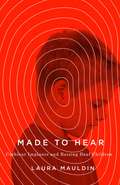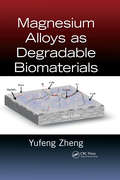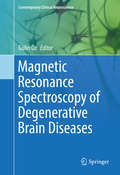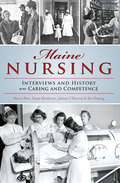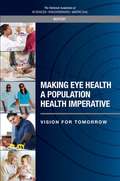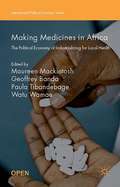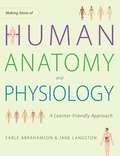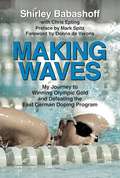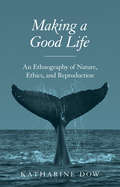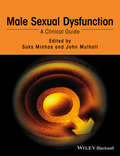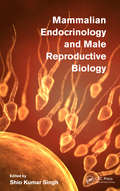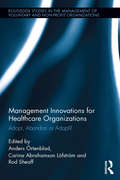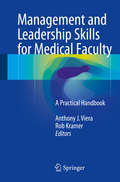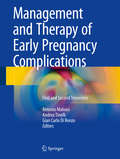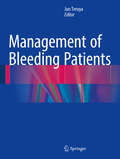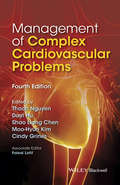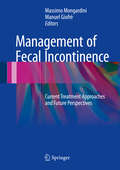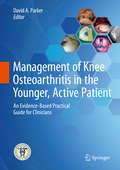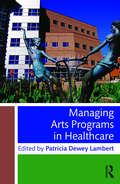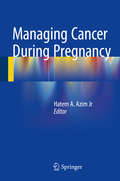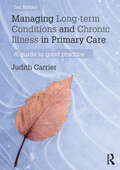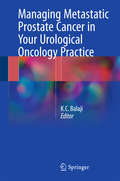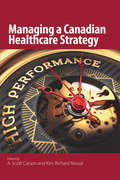- Table View
- List View
Made to Hear: Cochlear Implants and Raising Deaf Children (A Quadrant Book)
by Laura MauldinA mother whose child has had a cochlear implant tells Laura Mauldin why enrollment in the sign language program at her daughter&’s school is plummeting: &“The majority of parents want their kids to talk.&” Some parents, however, feel very differently, because &“curing&” deafness with cochlear implants is uncertain, difficult, and freighted with judgment about what is normal, acceptable, and right. Made to Hear sensitively and thoroughly considers the structure and culture of the systems we have built to make deaf children hear.Based on accounts of and interviews with families who adopt the cochlear implant for their deaf children, this book describes the experiences of mothers as they navigate the health care system, their interactions with the professionals who work with them, and the influence of neuroscience on the process. Though Mauldin explains the politics surrounding the issue, her focus is not on the controversy of whether to have a cochlear implant but on the long-term, multiyear undertaking of implantation. Her study provides a nuanced view of a social context in which science, technology, and medicine are trusted to vanquish disability—and in which mothers are expected to use these tools. Made to Hear reveals that implantation has the central goal of controlling the development of the deaf child&’s brain by boosting synapses for spoken language and inhibiting those for sign language, placing the politics of neuroscience front and center.Examining the consequences of cochlear implant technology for professionals and parents of deaf children, Made to Hear shows how certain neuroscientific claims about neuroplasticity, deafness, and language are deployed to encourage compliance with medical technology.
Magnesium Alloys as Degradable Biomaterials
by Yufeng ZhengMagnesium Alloys as Degradable Biomaterials provides a comprehensive review of the biomedical applications of biodegradable magnesium and its alloys. Magnesium has seen increasing use in orthopedic and cardiovascular applications over the last decade, particularly for coronary stents and bone implants.The book discusses the basic concepts of biodeg
Magnetic Resonance Spectroscopy of Degenerative Brain Diseases
by Gülin ÖzThe proposed book will act as a guide for scientists and clinicians to the unique information that MRS can provide. It will be a comprehensive overview of clinical and pre-clinical MRS applications and potential clinical utility of MRS biomarkers in degenerative brain diseases from leading experts in the field. MRS has proven to be a powerful complementary tool to MRI for the diagnosis and monitoring of disease progression and response to treatment because it can detect changes in cell density, cell type, and biochemical composition, not just structural changes. As the population in the developed world continues to age, neuroimaging for diagnosis, prognosis, and therapy monitoring of neurodegenerative diseases becomes increasingly important and there has been a recent surge of clinical and pre-clinical applications of MRS indicating that this technique can provide robust and non-invasive biomarkers of degeneration.
Magnetic Resonance Spectroscopy of Degenerative Brain Diseases (Contemporary Clinical Neuroscience)
by Gülin ÖzThe proposed book will act as a guide for scientists and clinicians to the unique information that MRS can provide. It will be a comprehensive overview of clinical and pre-clinical MRS applications and potential clinical utility of MRS biomarkers in degenerative brain diseases from leading experts in the field. MRS has proven to be a powerful complementary tool to MRI for the diagnosis and monitoring of disease progression and response to treatment because it can detect changes in cell density, cell type, and biochemical composition, not just structural changes. As the population in the developed world continues to age, neuroimaging for diagnosis, prognosis, and therapy monitoring of neurodegenerative diseases becomes increasingly important and there has been a recent surge of clinical and pre-clinical applications of MRS indicating that this technique can provide robust and non-invasive biomarkers of degeneration.
Maine Nursing: Interviews and History on Caring and Competence
by Susan Henderson Valerie Hart Juliana L'Heureux Ann SossongMaine nurses have served tirelessly as caregivers and partners in healing at home and abroad, from hospitals to battlefields. The Division of Public Health Nursing and Child Hygiene was established in 1920 to combat high rates of infant mortality in Washington and Aroostook Counties. During the Vietnam War, Maine nurses helped build the Twelfth Evacuation Hospital at Cu Chi and bravely assisted surgeries in the midst of fighting. In the early 1980s, nurse disease prevention educators in Portland rose to the challenge of combating the growing AIDS epidemic. Through historical anecdotes and fascinating oral histories, discover the remarkable sacrifices and achievements of Maine's nurses.
Making Eye Health a Population Health Imperative: Vision for Tomorrow
by Engineering Medicine National Academies of SciencesThe ability to see deeply affects how human beings perceive and interpret the world around them. For most people, eyesight is part of everyday communication, social activities, educational and professional pursuits, the care of others, and the maintenance of personal health, independence, and mobility. Functioning eyes and vision system can reduce an adult’s risk of chronic health conditions, death, falls and injuries, social isolation, depression, and other psychological problems. In children, properly maintained eye and vision health contributes to a child’s social development, academic achievement, and better health across the lifespan. The public generally recognizes its reliance on sight and fears its loss, but emphasis on eye and vision health, in general, has not been integrated into daily life to the same extent as other health promotion activities, such as teeth brushing; hand washing; physical and mental exercise; and various injury prevention behaviors. A larger population health approach is needed to engage a wide range of stakeholders in coordinated efforts that can sustain the scope of behavior change. The shaping of socioeconomic environments can eventually lead to new social norms that promote eye and vision health. Making Eye Health a Population Health Imperative: Vision for Tomorrow proposes a new population-centered framework to guide action and coordination among various, and sometimes competing, stakeholders in pursuit of improved eye and vision health and health equity in the United States. Building on the momentum of previous public health efforts, this report also introduces a model for action that highlights different levels of prevention activities across a range of stakeholders and provides specific examples of how population health strategies can be translated into cohesive areas for action at federal, state, and local levels.
Making Medicines in Africa: The Political Economy of Industrializing for Local Health (International Political Economy Series)
by Maureen Mackintosh Geoffrey Banda Paula Tibandebage Watu WamaeThe importance of the pharmaceutical industry in Sub-Saharan Africa, its claim to policy priority, is rooted in the vast unmet health needs of the sub-continent. Making Medicines in Africa is a collective endeavour, by a group of contributors with a strong African and more broadly Southern presence, to find ways to link technological development, investment and industrial growth in pharmaceuticals to improve access to essential good quality medicines, as part of moving towards universal access to competent health care in Africa. The authors aim to shift the emphasis in international debate and initiatives towards sustained Africa-based and African-led initiatives to tackle this huge challenge. Without the technological, industrial, intellectual, organisational and research-related capabilities associated with competent pharmaceutical production, and without policies that pull the industrial sectors towards serving local health needs, the African sub-continent cannot generate the resources to tackle its populations' needs and demands.
Making Sense of Human Anatomy and Physiology: A Learner-Friendly Approach
by Earle Abrahamson Jane LangstonDesigned to be user-friendly and informative for both students and teachers, this book provides a road map for understanding problems and issues that arise in the study of anatomy and physiology. Students will find tips to develop specific study skills that lead to maximum understanding and retention. They will learn strategies not only for passing an examination or assessment, but also for permanently retaining the fundamental building blocks of anatomical study and application. For the teacher and educator, the book provides useful insight into practical and effective assessment techniques, explores the subject matter from a learning approach perspective, and considers different methods of teaching to best to convey the message and meaning of anatomy and physiology. Supported by clear diagrams and illustrations, this is a key text for teachers who want a useful toolbox of creative techniques and ideas that will enhance the learning experience. In addition to the wealth of information it provides, Making Sense of Human Anatomy and Physiology sets in place a bedrock of learning skills for future study, regardless of the subject. Students of beauty therapies, holistic and complementary therapies, and fitness professionals--yoga teachers, personal trainers, sports coaches, and dance teachers--will gain not only a basic understanding of anatomy and physiology, but also the skills to learn such a subject. Allied professionals in nursing, biomedical science, dentistry, occupational therapy, physiotherapy, midwifery, zoology, biology and veterinary science will also find this book an invaluable resource. The final chapters offer suggestions for the further exploration of concepts, assessment, learning activities, and applications.
Making Waves: My Journey to Winning Olympic Gold and Defeating the East German Doping Program
by Chris Epting Shirley Babashoff<p>In her extraordinary swimming career, Shirley Babashoff set thirty-nine national records and eleven world records. Prior to the 1990s, she was the most successful U.S. female Olympian and, in her prime, was widely considered to be the greatest female swimmer in the world. <p>Heading into the 1976 Olympic Games in Montreal, Babashoff was pictured on the cover of Sports Illustrated and followed closely by the media. Hopes were high that she would become “the female Mark Spitz.” <p>All of that changed once Babashoff questioned the shocking masculinity of the swimmers on the East German women’s team. Once celebrated as America’s golden girl, Babashoff was accused of poor sportsmanship and vilified by the press with a new nickname: “Surly Shirley.” <p>Making Waves displays the remarkable strength and resilience that made Babashoff such a dynamic champion. From her difficult childhood and beginnings as a determined young athlete growing up in Southern California in the 1960s, through her triumphs as the greatest female amateur swimmer in the world, Babashoff tells her story in the same unflinching manner that made her both the most dominant female swimmer of her time and one of the most controversial athletes in Olympic history.</p>
Making a Good Life: An Ethnography of Nature, Ethics, and Reproduction
by Katharine DowMaking a Good Life takes a timely look at the ideas and values that inform how people think about reproduction and assisted reproductive technologies. In an era of heightened scrutiny about parenting and reproduction, fears about environmental degradation, and the rise of the biotechnology industry, Katharine Dow delves into the reproductive ethics of those who do not have a personal stake in assisted reproductive technologies, but who are building lives inspired and influenced by environmentalism and concerns about the natural world's future.Moving away from experiences of infertility treatments tied to the clinic and laboratory, Dow instead explores reproduction and assisted reproductive technologies as topics of public concern and debate, and she examines how people living in a coastal village in rural Scotland make ethical decisions and judgments about these matters. In particular, Dow engages with people's ideas about nature and naturalness, and how these relate to views about parenting and building stable environments for future generations. Taking into account the ways daily responsibilities and commitments are balanced with moral values, Dow suggests there is still much to uncover about reproductive ethics. Analyzing how ideas about reproduction intersect with wider ethical struggles, Making a Good Life offers a new approach to researching, thinking, and writing about nature, ethics, and reproduction.
Male Sexual Dysfunction: A Clinical Guide
by John Mulhall Suks MinhasSexual dysfunction affects men of all ages and incidence rates are expected to double by 2025 resulting in a major health burden. Though normal sexual function is an important aspect of health and well-being, sadly, this common condition still carries an associated stigma. As a result, affected men are often reluctant to approach their doctor and, instead, may live for many years with sexual dysfunction, often to the detriment of their personal lives. Male Sexual Dysfunction: A Clinical Guide covers all the common problems encountered by the clinician in this rapidly expanding and developing field. With full color throughout, this easy to read guide provides a comprehensive and systematic approach to patient management. Packed with key features, every chapter will contain flow diagrams and algorithms, key points, clinical pearls, ?what to avoid? boxes, and numerous tables, graphs and photographs . This book provides: Comprehensive focus on the core clinical areas of physiology/pharmacology, investigation, diagnosis, management and surgical options Coverage of all treatment pathways, including psychological, pharmacologic and surgical A straightforward, logical approach to clinical management An experienced and international editor and contributor team Expertly-written, this book is the perfect resource for urologists and general practitioners with an interest in this highly topical area, as well as those about to undergo their urology trainee examinations.
Mammalian Endocrinology and Male Reproductive Biology
by Shio Kumar SinghMammalian Endocrinology and Male Reproductive Biology provides comprehensive and current coverage of the area of endocrinology and male reproductive biology, covering not just humans, but mammals in general. Written by international experts in their respective fields, this multi-author book also covers the latest developments in genomics of androge
Management Innovations for Healthcare Organizations: Adopt, Abandon or Adapt? (Routledge Studies in the Management of Voluntary and Non-Profit Organizations)
by Anders Örtenblad, Carina Abrahamson Löfström and Rod SheaffInnovations in management are becoming more numerous and diverse, and are appearing in organizations providing many different kinds of products and services. The purpose of this book is to examine whether some widely-promoted examples of these management innovations – ranging from techniques such as Kaizen to styles of leadership and the management of learning – can usefully be applied to organizations which provide healthcare, and applied in different kinds of health systems. Management Innovations for Healthcare Organizations is distinctive in selecting a wide and diverse range and selection of managerial innovations to examine. No less distinctively, it makes an adaptive, critical scrutiny of these innovations. Neither evangelist nor nihilist, the book instead considers how these innovations might be adapted for the specific task of providing healthcare. Where evidence on these points is available, the book outlines that too. Consequently the book takes an international approach, with contributions from Europe, the Middle East, Australia and North America. Each contributor is an expert in the management innovation which they present. This combination of features makes the book unique.
Management and Leadership Skills for Medical Faculty
by Anthony J. Viera Rob KramerRecognizing that medical faculty face differentquestions or issues in different stages of their careers, this handy, practical title offers acomprehensive roadmap and range of solutions to common challenges in thecomplex and changing Academic Medical Center (AMC). With critical insights andstrategies for both aspiring and seasoned academicians, this handbook offers aconcise guide for personal career development, executive skill acquisition, andleadership principles, providing actionable, targeted advice for facultyseeking help on a myriad of new issues and situations. Pressures in today's Academic Medical Centerinclude significant changes to the healthcare system, competition for researchfunding, transformation of medical education, and recruitment and retention ofthe ever-evolving workforce. This dynamic environment calls for razor-sharpleadership and management effectiveness to stay competitive. AMC faculty aspireto formal leadership roles for a variety of reasons: to set a new vision, tocreate change, or to affect policy and resource decisions. For others,weariness of past leadership styles or mistakes may catalyze wanting a chanceto set a different tone. In the end, promotional opportunities often come withgreat administrative and management responsibilities. Management and Leadership Skillsfor Medical Faculty: A Practical Handbook isa must-have resource for faculty in AMCs and anyone with a role in healthcareleadership.
Management and Therapy of Early Pregnancy Complications
by Andrea Tinelli Antonio Malvasi Gian Carlo RenzoThis richly illustrated book draws on recently acquired knowledge to provide the reader with comprehensive, up-to-date information on the full range of obstetric complications that may be encountered during the first and second trimesters of pregnancy. For all complications, including those potentially involved in malpractice issues, risk factors and clinical presentation are described and detailed guidance is provided on the appropriate treatment. The lucid text is complemented by a wealth of images, diagrams, flow charts, and drawings. The volume has been compiled in collaboration with a large group of gynecologists, obstetricians and internationally renowned scientists to provide an essential guide. Accordingly, this book will be a valuable tool for every obstetrician and gynecologist. Practitioners across the world will be enabled to deepen their knowledge and to refine their approach to complications in daily clinical practice.
Management of Bleeding Patients
by Jun TeruyaThis volume provides a comprehensive and state-of-the-art overview of the major issues specific to managing bleeding patients. The sections of the book have been structured to review the overall scope of issue, among them bleeding conditions, managing bleeding including clearing patients for surgery, and massive bleeding during surgery. Reflecting the multidisciplinary care that is an integral part of managing bleeding patients, the book is written by authors from a variety of integrated disciplines, including transfusion medicine, hematology, pediatric hematology, critical care medicine, pediatric critical care medicine, obstetrics, and anesthesia. The volume also includes brief etiology and a practical reference guide regarding type of blood components, medication, dose, and duration. Management of Bleeding Patients is a valuable resource for clinicians working in the area of bleeding management.
Management of Complex Cardiovascular Problems
by Shao Liang Chen Thach Nguyen Dayi Hu Moo-Hyun Kim Cindy L. Grines Faisal LatifPatients with complex cardiovascular problems pose a special management challenge for both the specialist and the non-specialist. This book helps you approach difficult cases with the confidence to strategically map care, understand the risk profile of your patient, and make effective treatment decisions. Dependable and succinct content provides high yield information for the busy cardiologist Take home call outs, and critical thinking boxes provide candid advice on incorporating guidelines and evidence based medicine into your practice New convenient pocket-sized format New chapter addressing cardiovascular problems in women Discussion of high risk factors for and strategic care mapping encourage clinical focus Clinical pearls offer expert advice on topical issues Includes emerging trends and clinical trials keeping you up to date
Management of Fecal Incontinence
by Massimo Mongardini Manuel GiofrèThis book presents state of the art knowledge regarding the pathophysiology and diagnosis of fecal incontinence and describes and illustrates all relevant treatment techniques. In addition to the approaches that have been the mainstay of treatment of fecal incontinence to date, it covers recent innovations and emerging options, including neurostimulation, pioneering techniques exploiting the potential of stem cells, biofeedback training, reconstructive surgery, and advances in biomedical engineering applicable to replacement surgery. Fecal incontinence is a common, socially debilitating disorder of multifactorial etiology that poses many management challenges. This book will assist all relevant medical specialists, including surgeons, neurologists, gastroenterologists, urogynecologists, and other clinicians, in achieving correct and timely diagnosis and delivering effective therapy that reflects the ongoing revolution in treatment.
Management of Knee Osteoarthritis in the Younger, Active Patient
by David A. ParkerThis book is a rich source of practical guidance on the management of relatively young patients with osteoarthritis of the knee that will assist physicians and allied health professionals in enabling patients to remain active and sustain their quality of life. It provides up-to-date knowledge on the available treatment options, describes the evidence base for each option, and identifies the appropriate timing and indications. The book opens by considering the basic science behind osteoarthritis, which is critical to management. The many nonsurgical treatment modalities are then discussed, with particular focus on the importance of a multidisciplinary approach. Subsequent chapters address the role of surgical management, covering both techniques that attempt to preserve and possibly restore the native knee joint, such as meniscal and chondral surgery, arthroscopic debridement, and osteotomy for realignment of the joint, and those that involve joint replacement. The arthroplasty component of the text encompasses all areas of prosthetic resurfacing, including localized resurfacing, unicompartmental replacement, and total knee replacement. The book has been produced in cooperation with ISAKOS and the authors constitute an international faculty who provide a truly global perspective on the subject.
Managing Arts Programs in Healthcare
by Patricia Dewey LambertA growing body of research demonstrates how the arts – including literary, performing and visual arts as well as architecture and design – can greatly enhance the experience of healthcare, contributing to improved health outcomes, a better patient experience and lower healthcare costs. This unique book provides an overview of what the arts in healthcare can achieve and how to implement the arts in the most effective manner. Exploring possibilities for innovative program design and implementation – from healing gardens through public performances to bedside activities – the text draws on examples from a wide range of arts. The book then goes on to look at how programs can be aimed at specific populations and fields, such as children, palliative care and caregivers. This comprehensive book is an invaluable reference for all those studying or engaged in creating, designing, managing and evaluating arts in healthcare programs and initiatives.
Managing Cancer during Pregnancy
by Hatem A. Azim JrThis book provides hands-on information on how to manage pregnant cancer patients in clinical practice. In this context a multidisciplinary perspective is essential, and contributions are accordingly presented from experts in surgical management, medical oncology, radiotherapy, pharmacokinetics, obstetric care, psychological care, neonatal and pediatric care. In addition a series of chapters focused on management in particular disease settings are presented, including breast cancer, melanoma, cervical cancer, ovarian tumors, lymphoma, leukemia, and thoracic cancers. The book reflects the major progress that has been achieved in the care of pregnant cancer patients in the recent years as important data have become available on patient management, and fetal safety in addition to valuable preclinical research on the impact of pregnancy on pharmacokinetics of anti-cancer agents. Edited and authored by worldwide leaders in the field, it will serve as a valuable resource not only for oncologists but also for obstetricians, gynecologists, neonatologists, and pediatricians caring for pregnant cancer patients and their newborns.
Managing Long-term Conditions and Chronic Illness in Primary Care: A Guide to Good Practice
by Judith CarrierEffective management of long-term conditions is an essential part of contemporary nursing policy and practice. Systematic and evidence-based care which takes account of the expert patient and reduces unnecessary hospital admissions is vital to support those with long-term conditions/chronic diseases and those who care for them. Reflecting recent changes in treatment, the nurse’s role and the patient journey and including additional content on rehabilitation, palliative care, and non-medical prescribing, this fully updated new edition highlights the key issues in managing long-term conditions. It provides a practical and accessible guide for nurses and allied health professionals in the primary care environment and covers: -????????? the physical and psychosocial impact of long-term conditions -????????? effective case management -????????? self-management and the expert patient -????????? behavioural change strategies and motivational counselling -????????? telehealth and information technology -????????? nutritional and medication management. Packed with helpful, clearly written information, Managing Long-term Conditions and Chronic Illness in Primary Care includes case studies, fact boxes and pointers for practice. It is ideal reading for pre- and post-registration nursing students taking modules on long-term conditions, and will be a valuable companion for pre-registration students on community placements.
Managing Metastatic Prostate Cancer In Your Urological Oncology Practice
by K. C. BalajiThis text provides a comprehensive review of pathophysiology, molecular and cell biology aspects of CRPC, discusses all major clinical trials that have led to approval of 6 new drugs since 2004, explores the role of bone preservation strategies, in depth analysis of combination and sequencing strategies, outlines upcoming novel drugs and trends in research, and stresses the role of palliative care in this incurable disease. Managing Metastatic Prostate Cancer in Your Urological Oncology Practice will serve as a very useful resource for physicians and researchers dealing with, and interested in prostate cancer. It provides a concise yet comprehensive summary of the current status of the field that will help guide patient management and stimulate investigative efforts. All chapters are written by experts in their fields and will include the most up to date scientific and clinical information.
Managing Myeloproliferative Neoplasms
by Mesa, Ruben A. and Harrison, Claire N. Ruben A. Mesa Claire N. HarrisonThis is a concise, practical, case-based book documenting examples and scenarios that will help you manage challenging clinical issues for patients with myeloproliferative neoplasms. The editors and authors have strived to distil the very latest information in this rapidly advancing field in a way that will help you to update your practice and manage your patients. The key focuses are: diagnosis, both standard and challenging; both day-to-day management as well as special situations such as surgery, thrombotic events and pregnancy; and finally, managing evolving situations with MPN such as progression to acute myeloid leukemia. This book is an outstanding resource that includes a discussion of both classical myeloproliferative neoplasms, such as essential thrombocythemia, polycythemia vera and myelofibrosis, and also less common disorders such as systemic mast cell disease, hypereosinophilia, MPN/MBS overlap syndromes and atypical CML, amongst others. This book is a practical reference for practitioners, hematologists, medical oncologists and trainees.
Managing a Canadian Healthcare Strategy
by A. Scott Carson Kim Richard NossalCanada’s fragmented healthcare system is one of the most expensive among the OECD countries, yet the quality of its performance is mediocre at best. Canada lacks a system-wide healthcare strategy that brings together many individual federal, provincial, and territorial strategies into a comprehensive and coherent whole. Managing a Canadian Healthcare Strategy is a collection of ten policy research essays by leading Canadian and international scholars who address three important questions. First, if Canada had a unifying strategy, how would the country measure its success and monitor its performance? Second, who are the agents of change to bring about a Canadian system-wide strategy? Third, how can the jurisdictional realities of Canada’s political system be managed to bring about strategic reform? The final section in the volume explores ways to overcome the barriers and impediments that preoccupy Canadians’ concerns about healthcare. A companion volume to Toward a Healthcare Strategy for Canadians, the contributors to Managing a Canadian Healthcare Strategy turn to the critical importance of how necessary healthcare changes can be best implemented.
